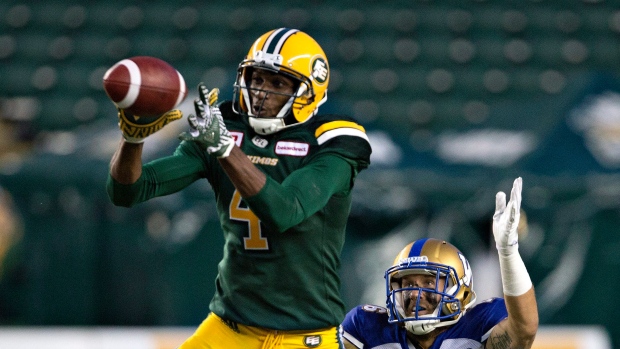Jun 20, 2017
Eskimos enter 2017 with high-flying offence, suspect defence
The fortunes of the Edmonton Eskimos in 2017 rest on a high-flying offence, fixing a suspect defence, and spiking a recurring problem with penalties.
The Canadian Press

EDMONTON — The fortunes of the Edmonton Eskimos in 2017 rest on a high-flying offence, fixing a suspect defence, and spiking a recurring problem with penalties.
It's Year Two of head coach Jason Maas's up-tempo offence, which focuses on options at the line, adjustments on the fly, and multiple reads and progressions by quarterback Mike Reilly on every play.
"There's not a single play that we'll put in our offence that doesn't have answers for any possible thing that a defence can do," Reilly said.
"That puts a lot of added workload on the players in the sense the wide receivers have to know what's going on (beyond their own assignments). They have to be at the right depths and landmarks and the quarterbacks have to know their reads."
Receiver Adarius Bowman agreed.
"Within the play is almost three plays," he said.
"In the beginning it can definitely feel overwhelming, but once you understand it … you feel like you know the answer to the test before it happens."
Last season, Reilly and the pass-catching duo of Bowman and Derel Walker shredded defences. Edmonton averaged almost 419 yards a game in net offence, best in the CFL. Edmonton averaged 30.5 points a game, second only to Calgary's 32.6
Coming off a Grey Cup win in 2015, Edmonton finished with a 10-8 record and a crossover loss to Ottawa in the CFL's Eastern Final last season.
Reilly led all quarterbacks in yards passing, while Bowman and Walker were one-two respectively in receiving yards.
Walker has since left to try his luck with Tampa Bay in the NFL.
Among the other receivers, Brandon Zylstra, looks to build on a strong finish to 2016. Longtime Eskimo Shamawd Chambers is back after a year in Saskatchewan. Chris Getzlaf, Vidal Hazelton, and Bryant Mitchell are also in the mix.
John White returns as running back, coming off an 886-yard rushing season, fourth best in the CFL. Ageless wonder Calvin McCarty is back at the fullback spot for his 11th season in green and gold.
Reilly will throw behind a strong offensive line anchored by centre Justin Sorensen and twin tower guards Simeon Rottier (six-foot-six ) and Matt O'Donnell (six-foot-11). Joel Figueroa will start at one tackle position, while Tony Washington and Colin Kelly fought it out in training camp at the other end of the line.
On defence, Mike Benevides' squad put up average numbers in 2016: fifth in points allowed per game (27.6) and sixth in net offence allowed (375 yards a game). On top of that, linebacker and special teams tornado Deon Lacey has left for the NFL and his replacement, Argonaut veteran Cory Greenwood, suffered a season-ending knee injury in training camp.
The heart of the defence remains middle linebacker J.C. Sherritt. The Eastern Washington product is now in his seventh year, recording 77 defensive tackles and six forced fumbles in 17 games last season.
Veterans Odell Willis, Almondo Sewell, and Marcus Howard return to the defensive line alongside Philip Hunt and newcomer Euclid Cummings, a free agent signing from Winnipeg.
Question marks remain in the secondary that allowed more than 305 yards passing a game. Neil King is back at safety along with veteran Marcell Young, newcomer free agent Johnny Adams, Garry Peters and Brandyn Thomspon.
Sean Whyte returns to kick field goals after an impressive 2016. He led the league with a 93.8 field goal percentage. He'll also handle the punting following the off-season departure of Grant Shaw.
The other major change for Edmonton happened not on the field but in the front office. General manager Ed Hervey left in April over contract talks and philosophical differences with team management. Former Ottawa Redblack assistant GM Brock Sunderland has since been hired.
The key will also be penalties. Edmonton was flagged 206 times last year, including calls that were declined. Only Saskatchewan (209) was worse.
The trend continued this pre-season. In two games, Edmonton was flagged 35 times for 328 yards.
Maas said that is being addressed.
"We've got a board set up in our hallway that pays attention to every penalty a guy gets," he said.
"I call them out every day out in the meetings, every day after practice, so you get a routine going of who are the main culprits. The main culprits more than likely are not going to be here and that's where you really set the tone."

